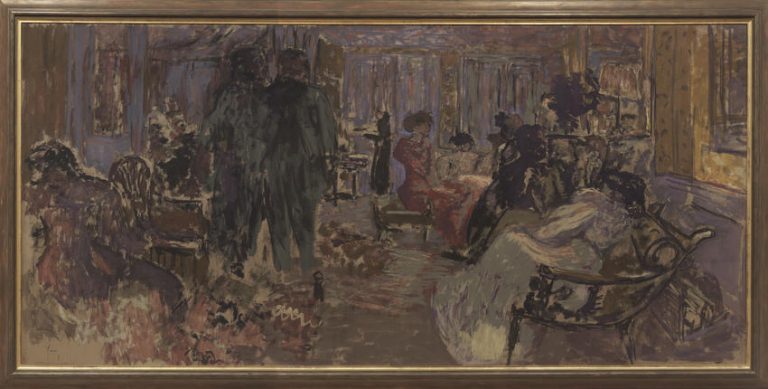We acknowledge the Traditional Owners of the land on which the Queensland Art Gallery | Gallery of Modern Art stands and recognise the creative contribution First Australians make to the art and culture of this country.

Édouard Vuillard / France 1868–1940 / Le salon des Hessel c.1905 / Distemper on canvas / 177.5 x 379.5cm / Purchased 1981. Queensland Art Gallery Foundation / Collection: Queensland Art Gallery | Gallery of Modern Art
Édouard VuillardLe salon des Hessel c.1905
Not Currently on Display
This work depicts an evening gathering of art patrons, acquaintances and friends in the Rue de Rivoli home of Édouard Vuillard’s art dealer and his wife, Jos and Lucie Hessel.
It is painted on a large scale using a technique known as peinture à la colle, or distemper. Vuillard used this technique for many of his decorative interior panels and in his work for theatre backdrops. The distemper medium is a mixture of dry pigments with a glue made from rabbit skin.
Its flat finish is similar to the fresco mural technique in which pigments are mixed with plaster. The technique enhances the decorative potential of the image by emphasising surface and design over the tonal modelling of form characteristic of oil painting. Distemper is also flat and non-reflective, which made it suitable for stage sets and interior decorating. The composition’s snapshot-like quality can be attributed to the popularity of amateur photography in the late nineteenth century.
Vuillard acquired a Kodak box camera in 1897, which he used to make thousands of candid studies of friends and family. He often used these photographs to help compose his paintings.
Édouard Vuillard was a painter and graphic artist. He lived a quiet life with his mother, who was a significant inspiration for his work, until he was 60. He studied at the École des Beaux-Arts in Paris and then at the Académie Julian.
In the late 1890s, Vuillard became a commercial success due to his illustrative work, theatre designs and decorative panels. Completing a number of important commissions for wealthy clients in the 1890s, he achieved considerable recognition as perhaps the most outstanding painter of the group known as the Nabis.
Although his work was influenced by Japanese prints and the work of Edgar Degas, Paul Gauguin, Odilon Redon and Pierre Bonnard, Vuillard’s art was strongly individualistic. His preferred medium was oil paint on cardboard and he rarely strayed from the depiction of domestic scenes, often including family and friends. Art historians refer to Vuillard as an ‘intimist’ due to the feeling of intimacy his works evoked.
Discussion Questions
1. Looking at the figures in the painting, do you get a sense of who these people were or where they came from by how the artist painted them? Explain your answer.
2. This painting depicts an ordinary scene in an extraordinary way. What strategies has the artist used to make the figures seem ethereal or ghost-like?
Classroom Activities
1. Discuss the everyday activities of family life today. Think about a photographic snapshot of a family gathered inside a home. What would it look like? Imagine the scene as if you are looking through a doorway or window. Draw or paint the scene you imagine.
2. Take a series of snapshot photographs that capture different aspects of your home and the people inside. Translate this montage of images into a painting.